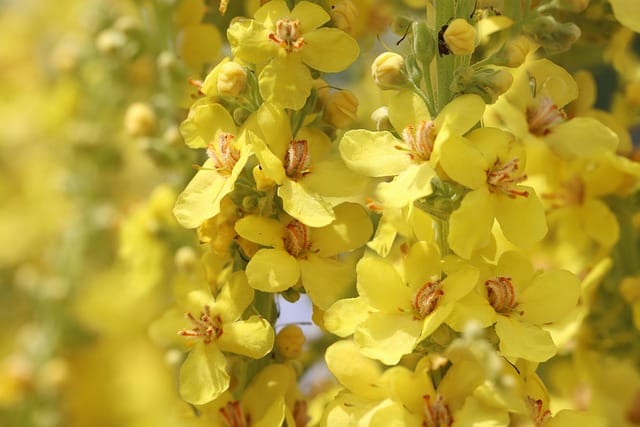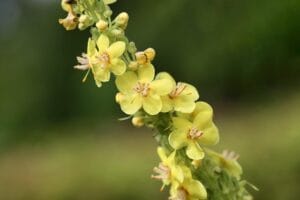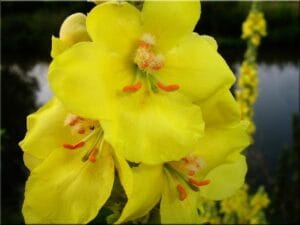Mullein Plant: Benefits, Care, Growing Tips & Uses
Introduction
The Mullein plant (Verbascum thapsus) is a remarkable herb that has been used for centuries in traditional medicine and herbal remedies. Known for its tall flowering spikes and soft, velvety leaves, Mullein is a hardy, low-maintenance plant that can grow in a variety of conditions. Whether you’re interested in its health benefits, attractive appearance, or ease of care, the Mullein plant is a great addition to any garden.
In this detailed guide, you’ll learn everything about Mullein – from its origins and uses to how to grow, care for, and harvest it effectively. Let’s dive into the world of this wonderful herb.
| Feature | Details |
| Common Name | Mullein |
| Scientific Name | Verbascum thapsus |
| Plant Type | Biennial herbaceous plant |
| Native Region | Europe, North Africa, Asia |
| Height | Up to 6 feet tall |
| Sunlight | Full sun |
| Soil Type | Well-drained, poor to moderately fertile soil |
| Watering | Low to moderate watering needs |
| Bloom Time | Summer (June to August) |
| Hardiness Zones | USDA zones 3-9 |
History and Origin of Mullein
Mullein has a rich history that dates back thousands of years. Originally native to Europe, North Africa, and parts of Asia, this plant has naturalized in North America and many other parts of the world. Ancient Greeks and Romans used Mullein for respiratory conditions, while Native American tribes valued it for its healing properties.
Historically, Mullein was also known as “torch plant” because its tall, dried stalks were dipped in animal fat and used as torches. Today, Mullein is popular among herbalists and natural health enthusiasts for its soothing properties and easy cultivation.
Types of Mullein Plant
There are over 250 species of Mullein, but a few varieties are particularly popular among gardeners and herbalists:
1. Common Mullein (Verbascum thapsus)
This is the most widely recognized species, famous for its tall yellow flower spikes and medicinal uses.
2. Moth Mullein (Verbascum blattaria)
A more ornamental type with purple or white flowers, known for attracting pollinators like bees and butterflies.
3. Purple Mullein (Verbascum phoeniceum)
Grown primarily for its striking purple flowers, this species adds vibrant color to gardens.
4. Greek Mullein (Verbascum olympicum)
Famous for its beautiful yellow blooms and tall structure, often grown as an ornamental plant.
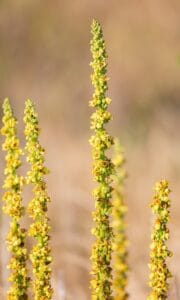
Mullein plant benefits
1. Respiratory Health
Mullein leaves and flowers are commonly used in teas, tinctures, and capsules to help with coughs, bronchitis, and asthma. It acts as an expectorant, helping clear mucus from the lungs.
2. Anti-Inflammatory Properties
Mullein contains compounds like saponins and flavonoids that reduce inflammation and soothe irritated tissues.
3. Ear Infections
Mullein-infused oil is a traditional remedy for earaches and ear infections.
4. Skin Health
The leaves can be made into salves to help treat wounds, burns, and skin infections.
5. Pollinator Friendly
Its tall, colorful flowers attract beneficial insects, such as bees and butterflies, making it a great addition to pollinator gardens.
How to Grow Mullein Plant
1. Choosing the Right Location
Mullein prefers full sun and thrives in areas with at least 6 to 8 hours of direct sunlight daily. It can grow in poor, rocky soil, making it ideal for low-maintenance gardens.
2. Soil Preparation
For successful Mullein growth, choose well-draining soil with a sandy or loamy texture. Mullein thrives in poor, rocky soils but adding a small amount of compost can enhance growth. Avoid heavy clay or overly rich soils. Maintain a neutral to slightly alkaline pH (6.0-7.5) for optimal plant health.
3. Planting Mullein
Planting Mullein is simple and rewarding. Sow seeds directly in well-drained soil during early spring. Choose a sunny spot, as Mullein thrives in full sunlight. Lightly press seeds onto the soil surface without covering them. Water gently and expect germination within two weeks, leading to healthy, low-maintenance plants.
4. Germination and Growth
Mullein seeds germinate quickly, usually within 10-14 days, when exposed to light. Sow seeds directly on the soil surface in spring. In the first year, the plant forms a low rosette of fuzzy leaves. By the second year, it develops a tall flowering stalk, reaching up to six feet high..
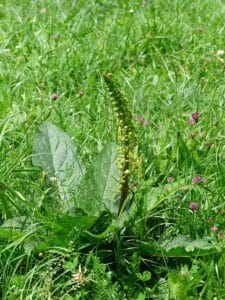
Mullein Plant Care Tips
1. Watering
Mullein requires minimal watering once established. Water young plants regularly until they develop strong roots. Afterward, mullein thrives in dry, well-drained soil with occasional watering during prolonged periods of drought. Overwatering should be avoided as it can cause root rot. Always let the soil dry out between watering for healthy plant growth.
2. Pruning
Pruning the Mullein plant is simple and beneficial. Regularly remove dead or damaged leaves to encourage healthy growth. After blooming, cut back the tall flower stalk to prevent unwanted self-seeding. Pruning also helps maintain a tidy appearance and promotes the plant’s overall vigor, especially during its active growing season.
3. Fertilization
Mullein plants generally do not require fertilization, as they thrive in poor, well-drained soils. Over-fertilizing can lead to excessive leafy growth with fewer flowers. If desired, you can add a light compost layer during planting to boost initial growth. Avoid high-nitrogen fertilizers to maintain strong, upright, and healthy plants.
4. Pest and Disease Management
Mullein is generally pest and disease resistant, making it an easy-care plant. Occasionally, aphids or spider mites may appear, especially in very dry conditions. Treat infestations with neem oil or insecticidal soap. Avoid overwatering to prevent root rot, and ensure good air circulation to keep the plant healthy.
5. Winter Care
During winter, Mullein requires minimal care as it is highly cold-tolerant. In its first year, the leaf rosette survives frost naturally. No mulching or special protection is needed. Simply leave the plant undisturbed; it will regrow and bloom in the second year, bringing beautiful flower spikes during summer.
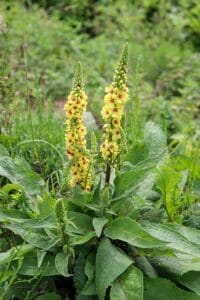
How to Harvest Mullein
- Leaves: Harvest young leaves in spring and early summer for medicinal use.
- Flowers: Pick flowers when they are fully open during mid-summer.
- Drying: Lay leaves and flowers flat in a well-ventilated area out of direct sunlight u
- Storage: Store in airtight containers in a cool, dry place for up to a year.
How to Use Mullein
1. Mullein Tea
- Ingredients: Dried Mullein leaves or flowers.
- Method: Steep 1-2 teaspoons in hot water for 10 minutes, strain well to remove the tiny hairs, and drink to soothe the throat and lungs.
2. Mullein Oil
- Use: Helps treat earaches. Infuse Mullein flowers in olive oil and apply a few drops in the ear (after consulting a healthcare provider).
3. Mullein Salve
- Mullein-infused oil can be made into a salve with beeswax for skin conditions like rashes and burns.
4. Smoking Mullein (Traditional Use)
- In some traditional practices, dried Mullein leaves are smoked to help clear lung congestion (always consult with a professional before use).
Mullein Plant in Landscaping
Mullein is not just a medicinal herb but also an attractive plant for naturalistic gardens. Its tall, striking flower spikes serve as vertical interest in borders and wildflower meadows. It looks stunning with companion plants like echinacea, yarrow, and black-eyed Susan.
Companion Planting Ideas:
- Good Companions: Echinacea, yarrow, lavender, sage.
- Avoid Planting With: Water-loving plants, as Mullein thrives in drier conditions.
Common Problems with Mullein Plant
| Problem | Cause & Solution |
| Yellow Leaves | Often caused by overwatering; let the soil dry out. |
| Leggy Growth | Too much shade or excess nitrogen; ensure full sun. |
| No Flowers | It may still be in its first year; flowering occurs in year two. |
| Unwanted Spreading | Remove spent flowers before seeds set to control spread. |
how to identify mullein plant
To identify the mullein plant, look for a tall, erect plant with a rosette of large, fuzzy, grayish-green leaves in the first year, followed by a single, tall flowering stalk in the second year, typically topped with a spike of small yellow flowers. The leaves are soft and velvety to the touch, and the plant often grows in disturbed areas or along roadsides.
Environmental Impact of Mullein
Mullein can be invasive in some regions because it self-seeds aggressively. In the USA, it’s considered a weed in some states, particularly in disturbed soils. However, responsible gardeners can manage this by deadheading flowers and limiting seed dispersal.
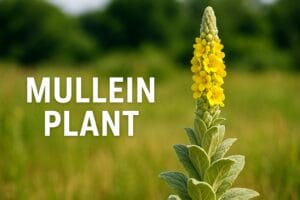
Eco-Friendly Tip:
If you live in an area where Mullein is invasive, you can still enjoy it by growing in containers or removing flower spikes before seeds mature.
FAQs About Mullein Plant
1. Is Mullein safe to consume?
Yes, when prepared properly, Mullein leaves and flowers are safe for consumption in teas and tinctures. Always strain well to remove plant hairs and consult a healthcare provider before medicinal use.
2. Can I grow Mullein in pots?
Yes! Mullein can be grown in large containers with good drainage. Ensure the pot gets plenty of sunlight.
3. Is Mullein a perennial plant?
No, Mullein is a biennial, meaning it grows foliage in the first year and flowers in the second year, then dies after flowering.
4. How do I prevent Mullein from spreading too much?
Simply remove the flower stalk before it goes to seed or deadhead the flowers regularly.
5. Does Mullein attract bees?
Yes, Mullein’s tall flower spikes are excellent for attracting bees and other pollinators.
6. What does Mullein smell like?
Mullein leaves have a mild, earthy scent, while the flowers have a subtle honey-like fragrance.
7. How tall does Mullein get?
Common Mullein can grow up to 6-7 feet tall, making it a striking feature in the garden.
Conclusion
The Mullein plant is a resilient, attractive, and highly beneficial herb that deserves a spot in any home garden. From its stunning tall yellow flower spikes to its wide range of traditional medicinal uses, Mullein offers beauty, health benefits, and low-maintenance gardening. With minimal care, this hardy plant will thrive in poor soil and bright sun, providing you with a natural remedy cabinet right in your backyard.

